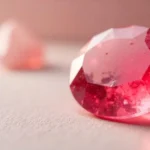Emeralds, with their vibrant green hue, have long captivated human imaginations, gracing the crowns and jewelry of royalty and wealthy collectors throughout history. While polished emeralds are most commonly seen adorning fine jewelry, raw emeralds hold a charm that is both rugged and timeless. These uncut, unpolished stones are not just a collector’s dream but also a true testament to the magnificent artistry of nature. In this comprehensive guide, we will explore the formation, value, care, and uses of raw emeralds, unveiling the allure of these gemstones in their purest, unrefined state.
Table of Contents
ToggleWhat is a Raw Emerald
A raw emerald is the natural, unprocessed form of the gemstone emerald. Unlike its polished counterpart, which is cut and shaped for jewelry, a raw emerald retains its original rugged texture and irregular shape as it is mined directly from the earth. These stones, in their uncut state, showcase a natural, unrefined beauty that appeals to collectors, jewelers, and enthusiasts alike. Raw emeralds are prized for their authenticity and connection to the earth, offering a direct link to the natural forces that shaped them.
Raw emeralds belong to the beryl mineral family, and their signature green color is a result of trace amounts of chromium and vanadium. Though they may lack the brilliance of their polished counterparts, raw emeralds are valued for their rarity, natural appearance, and potential to be transformed into high-quality gemstones.
The Formation of Raw Emeralds: A Geological Marvel
The formation of emeralds is a rare and fascinating geological process. These stunning gemstones develop in conditions that are quite unique and specific, contributing to their scarcity. Raw emeralds are typically found in hydrothermal veins or pegmatite deposits deep within the Earth’s crust, formed through a combination of heat, pressure, and the presence of specific minerals.
Here’s a breakdown of the formation process of emeralds:
Heat and Pressure: Deep within the Earth, intense heat and pressure cause beryllium, along with other trace minerals, to combine and crystallize, forming beryl crystals.
Chromium and Vanadium: These trace elements, which are found in varying amounts within the stone, give emeralds their signature green color. The more chromium and vanadium present, the more vibrant and intense the green hue.
Slow Cooling: Over millions of years, as the surrounding rock cools, the emeralds gradually crystallize. During this slow cooling process, various inclusions, or “jardin,” are often trapped inside, giving each stone a unique fingerprint and character.
This complex and slow formation process is one of the key reasons why raw emeralds are so rare and valuable. Each raw emerald is a product of millions of years of natural history, making them true treasures from the Earth.
Why Choose a Raw Emerald?
Raw emeralds have garnered increasing popularity in recent years, as more people appreciate their natural beauty and unique qualities. Whether you’re a gemstone enthusiast, a jewelry designer, or simply a lover of rare natural wonders, raw emeralds offer numerous reasons to choose them over their polished counterparts:
Unique Aesthetics
The rustic and organic appearance of raw emeralds is what sets them apart from polished stones. Their uncut form reveals an earthy, untamed beauty that can be appreciated by anyone who enjoys nature’s raw, unrefined artistry. Each raw emerald is unique, with variations in shape, color, and inclusions, making them one-of-a-kind treasures. The rough edges, unpolished surfaces, and natural textures showcase the untouched splendor of the gemstone in its rawest form.
Versatility in Jewelry
While polished emeralds are commonly used in jewelry, raw emeralds are gaining popularity for their distinctive and natural appeal. Jewelry designers and artisans use raw emeralds to create bespoke, one-of-a-kind pieces that exude originality and elegance. From rustic pendants and necklaces to statement rings and bracelets, raw emeralds add a touch of earthy charm to any design, allowing for the creation of truly personalized jewelry.
Collectible Value
Gem collectors often seek raw emeralds for their natural state and connection to the Earth. These uncut gemstones are seen as a window into the geological history of our planet, providing insight into the unique processes that gave rise to these precious stones. The rarity of high-quality raw emeralds adds to their appeal as collectible items, with many enthusiasts seeking out raw specimens as part of their gemstone collections.
Potential for Customization
One of the most exciting aspects of raw emeralds is their potential for customization. While raw emeralds can be appreciated in their uncut form, they also offer the opportunity to be transformed into polished gemstones or incorporated into unique jewelry designs. Jewelers and gem cutters can shape and polish raw emeralds to create gemstones that meet specific design preferences, making them a versatile and customizable option for those looking to create personalized pieces.
How to Identify a Genuine Raw Emerald
As raw emeralds gain popularity, the market has seen an increase in synthetic and imitation emeralds. To ensure that you are purchasing a genuine raw emerald, it’s essential to know how to identify the real thing. Here are some tips to help you distinguish an authentic raw emerald:
Check the Color
A genuine emerald will have a rich, vibrant green color. The shade of green can range from light and pastel hues to deeper, darker tones, but the key is that the color should be natural and consistent. While perfect uniformity in color might be a red flag, look for variations in the green tone that give the stone its unique characteristics. Be wary of stones that appear too bright or unnatural, as these may be synthetic or treated gemstones.
Inspect for Inclusions
Natural emeralds are known for their internal inclusions, which are often referred to as their “jardin” (French for “garden”). These inclusions are natural imperfections formed during the crystallization process and serve as a hallmark of authenticity. If you observe small, natural imperfections within the stone, it is likely a genuine raw emerald. Synthetic emeralds tend to have fewer inclusions and may appear overly flawless.
Test Hardness
Emeralds rank 7.5 to 8 on the Mohs scale of hardness, which means they are durable but can still be scratched by harder materials such as diamonds. If you are uncertain about the authenticity of a raw emerald, a hardness test can help confirm whether the stone is genuine.
Seek Professional Evaluation
If you’re ever in doubt, it’s always a good idea to seek the expertise of a certified gemologist. A professional can evaluate the raw emerald using specialized tools and techniques to confirm its authenticity, origin, and quality.
The Value of Raw Emeralds
Several factors contribute to the value of a raw emerald, making each one unique in its worth. These factors include the color, clarity, size, and origin of the stone.
Color
The most important factor in determining the value of an emerald, raw or polished, is its color. A rich, vibrant green with a balanced tone is the most sought-after. Too dark or too light can detract from the value of the stone, with the ideal emerald exhibiting a bright and clear green hue.
Clarity
While inclusions are common in raw emeralds, their presence affects the stone’s value. Fewer and less noticeable inclusions increase the stone’s clarity and its overall value. However, certain inclusions are actually appreciated for the character they bring to the raw stone, and some collectors specifically seek emeralds with distinctive or unique inclusions.
Size
Larger raw emeralds are rarer and, therefore, more valuable. However, size alone doesn’t dictate value—quality remains the primary consideration. A large emerald with poor clarity or color may not be as valuable as a smaller emerald with exceptional characteristics.
Origin
The origin of a raw emerald can also impact its value. Emeralds from renowned mining regions such as Colombia, Zambia, and Brazil are often of higher quality and command higher prices due to their historical significance and the unique conditions in which they were formed.
How to Care for Raw Emeralds
Raw emeralds, like all precious stones, require special care to maintain their natural beauty. Here are some tips on how to care for your raw emerald:
Avoid Harsh Chemicals
Avoid exposing your raw emerald to harsh chemicals, including household cleaning agents, as these can damage the stone’s surface. Always handle your emerald with clean hands and store it away from chemicals.
Clean Gently
To clean your raw emerald, use a soft cloth and warm, soapy water. Avoid using ultrasonic cleaners or steam cleaning, as these methods can exacerbate any existing inclusions or fractures in the stone.
Store Safely
Store your raw emerald in a soft pouch or padded box to prevent it from coming into contact with other stones that might scratch it. If possible, store your emerald separately from other gemstones to ensure its safety.
Protect from Impact
Emeralds, despite their hardness, are susceptible to chipping due to their natural inclusions. Always handle raw emeralds with care, and avoid dropping or banging the stone against hard surfaces.
Popular Uses of Raw Emeralds
Raw emeralds are prized not only for their aesthetic appeal but also for their versatility in various applications. Here are some popular uses of raw emeralds:
Jewelry
Raw emeralds are a popular choice for creating unique jewelry pieces. Their natural, unpolished look adds an element of rustic elegance to rings, necklaces, and earrings. Designers often use raw emeralds to craft bespoke jewelry, which highlights the natural beauty of the stone.
Collecting
Gem collectors appreciate raw emeralds for their connection to the earth and their geological significance. Raw emeralds provide a glimpse into the geological processes that shaped these precious stones, making them valuable collectibles.
Meditation and Healing
Emeralds have been traditionally believed to possess metaphysical properties that promote emotional healing and balance. Many people use raw emeralds in crystal healing practices, where they are thought to help with matters of the heart, including love, compassion, and wisdom.
Investment
High-quality raw emeralds are becoming increasingly valuable as their rarity continues to grow. As a result, they are often considered a sound investment, particularly for those looking to diversify their portfolio with unique, rare assets.
Where to Buy Raw Emeralds
When purchasing raw emeralds, it’s important to buy from a reputable seller. Here are some tips on where and how to purchase raw emeralds:
Research Vendors: Look for sellers with positive reviews and a strong reputation in the gemstone industry. Many trusted sellers specialize in raw gemstones and can provide certification of authenticity.
Request Certification: Ensure that the emerald comes with a certificate of authenticity from a recognized gemological institute. This helps confirm the stone’s quality and origin.
Inspect the Stone: If possible, inspect the raw emerald in person before purchasing it, or request high-quality images and videos to evaluate its condition.
Compare Prices: Be cautious of prices that seem too low for high-quality raw emeralds, as they may indicate synthetic or imitation stones.
Final Thoughts
Raw emeralds are more than just gemstones; they are natural works of art that tell the story of the Earth’s geological history. Whether you’re a collector, a jewelry enthusiast, or someone seeking a meaningful investment, raw emeralds offer unparalleled beauty and value. By understanding their formation, value, and care, you can truly appreciate these stunning green gems. Embrace the raw beauty of emeralds and let them add a touch of nature’s brilliance to your life.
FAQs
What is a raw emerald?
A raw emerald is an uncut, unpolished gemstone in its natural state, showcasing its rugged texture and natural beauty before any shaping or refining.
Can raw emeralds be used in jewelry?
Yes, raw emeralds are increasingly popular in jewelry design for their unique, rustic look, often used in custom, artisanal pieces such as rings and necklaces.
How do I identify a genuine raw emerald?
Genuine raw emeralds have a vibrant green color, often with inclusions (known as “jardin”). They should also rank 7.5–8 on the Mohs hardness scale.
Are raw emeralds valuable?
Raw emeralds can be valuable, especially if they have vivid color, minimal inclusions, and come from renowned regions like Colombia or Zambia. Their value also depends on size and quality.
How should I care for my raw emerald?
To care for raw emeralds, avoid harsh chemicals, clean them with a soft cloth and mild soapy water, and store them separately to avoid scratches and damage.










